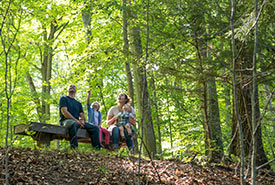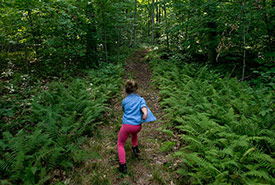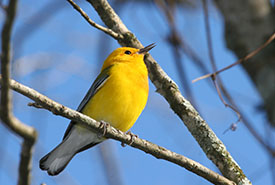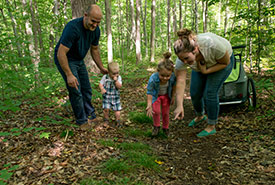Slow down, and connect

Colleen Dale believes the best way to educate Canada’s future conservationists is by taking them to explore her favourite place in nature: Ontario’s Backus Woods. (Photo by Neil Osbourne)
Ontario’s Backus Woods is a stellar example of one of Canada’s most diverse life zones.
Growing up in a time without the internet, Colleen Dale learned about nature the old-fashioned way: getting out into it.
“I can remember being around five years old and cloud-watching in my backyard,” she recalls. “I loved doing this — the freedom to dream and transport myself into a different time and space.”
As the former Backus Heritage Education Centre’s outdoor education coordinator, Colleen believes the best way to educate Canada’s future conservationists is by taking them to explore her favourite place in nature: Ontario’s Backus Woods.
A storehouse of discoveries

According to Colleen, spending time outside supports a child’s creativity and imagination, fosters curiosity and exploration and encourages problem solving. (Photo by Neil Osbourne)
“Spending time outside supports a child’s creativity and imagination, fosters curiosity and exploration and encourages problem solving,” says Colleen. “I have been teaching outdoor education for the last 10 years, and I am always amazed at the details a child will see when on a hike in Backus Woods.”
Many species live in Backus Woods, but one of Colleen’s favourites to see while exploring the area isn’t always a welcome sight to many visitors.
“There have been many warm sunny mornings I have been walking on the sand road and found an eastern hog-nosed snake sunning itself on the road,” she says. “I like the elaborate behaviours they display when threatened, and the eventual ‘playing dead’ strategy!”
Related blog posts
Diversity abounds
But for the ophiophobes planning to visit, there are plenty of other sights to see in this unique Ontario forest in one of the most diverse life zones in Canada.
“Backus Woods is in the Carolinian Zone and home to a diverse array of plant and animal species,” says Colleen. “The mix of southern and northern species gives Backus Woods a uniqueness I haven’t encountered in other forests in Ontario. It’s a place where you can go and find sugar maples and tuliptrees side by side, and spicebushes growing beneath the canopy.”
Backus Woods allows visitors to experience older-growth Carolinian forest and witness a variety of species that are found in few other places in Canada, including prothonotary and cerulean warbler, tuliptree and black gum. Since the property has not been logged in more than 65 years, its habitat is in excellent condition.

Prothonotary warbler (Photo by Bill Hubick)
Kristen Bernard, the Nature Conservancy of Canada’s (NCC’s) program director for southwestern Ontario, shares Colleen’s connection to Backus Woods:
“Backus Woods is an incredibly special place to me, to NCC and to the local community. A walk in Backus Woods transports you away from everyday life to somewhere special, where Carolinian trees tower, birdsongs ring out and forest critters dart about, reminding us of the little joys in life. It is a forest full of stories and wonder.”
Kristen notes that in 2016, Backus Woods was added to the core of the Long Point World Biosphere Reserve, a UNESCO designation that recognizes the ecological and cultural significance of Backus Woods. Backus Woods supports incredible biodiversity and has a long, proud history of conservation and good land stewardship.
A place to get up close with nature
Colleen’s favourite places to explore on the property include soft, mossy spots along Dedrick Creek’s edge and lookout spots at the base of a large tree on the edge of the forest.
When taking groups through Backus Woods, Colleen likes to explore fragments of the forest’s past.
“Many people might not know that there are remnants of an old sugar shack from when the Backus family owned the property,” she says.

According to Colleen, it’s essential for families to spend quality time together away from screens and the bombardment of daily distractions. (Photo by Neil Osbourne)
As a mother of two little girls, spending time in nature is something Colleen and her family have come to value in their busy lives.
“In our increasingly hectic and plugged-in society, it’s essential for families to spend quality time together away from screens and the bombardment of daily distractions,” she says. “It’s a time for us to slow down and connect with each other and share meaningful experiences that foster a deeper appreciation and gratitude for the amazing place we live in.”


